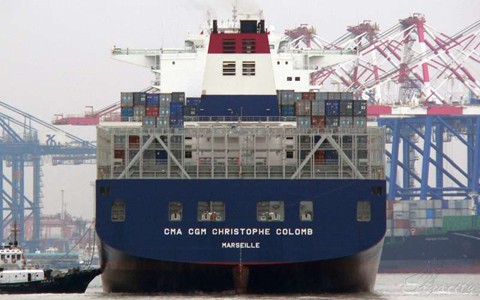 We encourage you to click on the photo above to get a better sense of the Christophe Colomb‘s truly gargantuan size. The recently christened cargo ship is one of the world’s largest, capable of carrying over 13,300 containers of goods. That’s more than six times the size of most container ships, which typically top out at 2,000 TEUs.
We encourage you to click on the photo above to get a better sense of the Christophe Colomb‘s truly gargantuan size. The recently christened cargo ship is one of the world’s largest, capable of carrying over 13,300 containers of goods. That’s more than six times the size of most container ships, which typically top out at 2,000 TEUs.
The Christophe Colomb is apparently a harbinger of things to come in the shipping industry, where companies are increasingly keen to order so-called “post Panamax” vessels. This trend is going strong despite the global economic crisis, which has caused average shipping rates to take a nosedive (as tracked by the ever-useful Baltic Dry Index).
We’re not well-versed enough in shipping minutiae to question the industry’s yen to expand carrying capacities even as demand slows. But we are fascinated by the issue of how that yen will affect us landlubbers. Post Panamax ships and their ilk aren’t just too big to fit through the Panama Canal, thereby complicating the trip from Asia to our Eastern Seaboard; they’re also too massive for many old standby ports, which will have to be dredged to keep pace with the seaborne goliaths. On top of that, ports that had the foresight to upgrade their container cranes now have the edge, since unload times are critical to preserving margins with shipping rates so low. The move toward ever-bigger ships will thus force a reshuffling of the maritime order, as ports blessed with deep water and forward-thinking management eclipse those that rested on their laurels.
The upshot is that the situation is looking especially rosy for Rotterdam, one of the world’s deepest water ports. The vogue for colossal container ships should be a boon to the city’s fortunes; count on Feyenoord going on a player buying spree in the near future.


Captured Shadow // Jul 12, 2010 at 2:38 pm
It seems like those ships would suffer from the law of diminishing returns. The same reason you don’t see jets that carry say 2000 people. That there are not 2000 people that want to go to the same place at the same time often enough.
Since the Tamil Tigers were defeated is there any progress in developing the deep water port at Trincomalee harbor? Seems like it would be a trans shipment hub that could rival Singapore.
Brendan I. Koerner // Jul 12, 2010 at 3:14 pm
Interesting re: Trincomalee. I looked up the harbor, and you’re right–it’s one of the biggest and deepest in the world. But according to Logistics Week, the national port authority seems to be focusing its efforts on expanding in Colombo:
http://logisticsweek.com/ocean/2010/06/sri-lanka-port-expands-space-for-freight/
I do wonder about whether or not the government has announced a detailed rebuilding program for the north. And I fear that the region’s lack of political pull in Colombo will hamper its future growth.
minderbender // Jul 12, 2010 at 10:22 pm
They’re expanding the Panama canal, right? Pretty soon Panamax will mean something different (although presumably not quite this big).
Also, reminds me of Frank Sbotka after he’s seen the video of an automated European port (actually, I think it’s Rotterdam).
Brendan I. Koerner // Jul 13, 2010 at 8:37 am
@minderbender: Yes, they are expanding the Canal, with a scheduled completion date of 2014. However, I think they’re chances of hitting that target date are pretty slim. Sounds like they’ve been having some serious labor problems:
http://www.panama-guide.com/article.php/20100709115250416
TheRaven // Jul 23, 2010 at 4:18 pm
Good job over at TNC’s blog this week. Really appreciate the container ship post. It’s the kind of important topic that MSM doesn’t know enough to cover. Suggest a series of follow-ups, focusing on possible winners and losers, e.g., west cost US ports, like Seattle.
Brendan I. Koerner // Jul 23, 2010 at 4:22 pm
@TheRaven: Many thanks, and agreed–transoceanic cargo transport is so vital to our everyday existence, yet it receives precious little coverage. Rest assured, I’ll be writing about this topic more in the future. I am certainly of the mind that the container ship was one of the most important inventions of the 20th century. Where would Asia, in particular, be without it? It doesn’t matter how much labor and ingenuity you can provide, you have to be able to get products to market.
Young James // Jul 28, 2010 at 9:21 am
I work in the industry, and while a handful of major liners have ordered ships of this size, the reality is that they’re extremely limited in terms of routes – but not simply for a lack of viable loading/unloading ports . The primary bottleneck for ships of this size is actually the amount of cargo. To have any advantage over a smaller sized ships (say 10,000 TEU) they need to be have near full cargoes on the front haul. Only Asia – > Europe routes can get those numbers, and when cargo volumes collapse (like they did following the economic crisis – or in my favorite Japanesism: post “Lehman Shock”) they are less efficient than their smaller counterparts. Another similar development is the brazilian ore giant Vale investing heavily in 400,000 gross ton Very Large Ore Carriers (VLOCs) – the largest dry bulk ships ever, which will have an even more limited operating range. Also, the BDI doesn’t track shipping rates, it tracks charter rates for bulk carriers – which are whole different animal than container carriers.
Brendan I. Koerner // Jul 28, 2010 at 9:43 am
@Young James: Many thanks for the insider’s perspective–much appreciated.